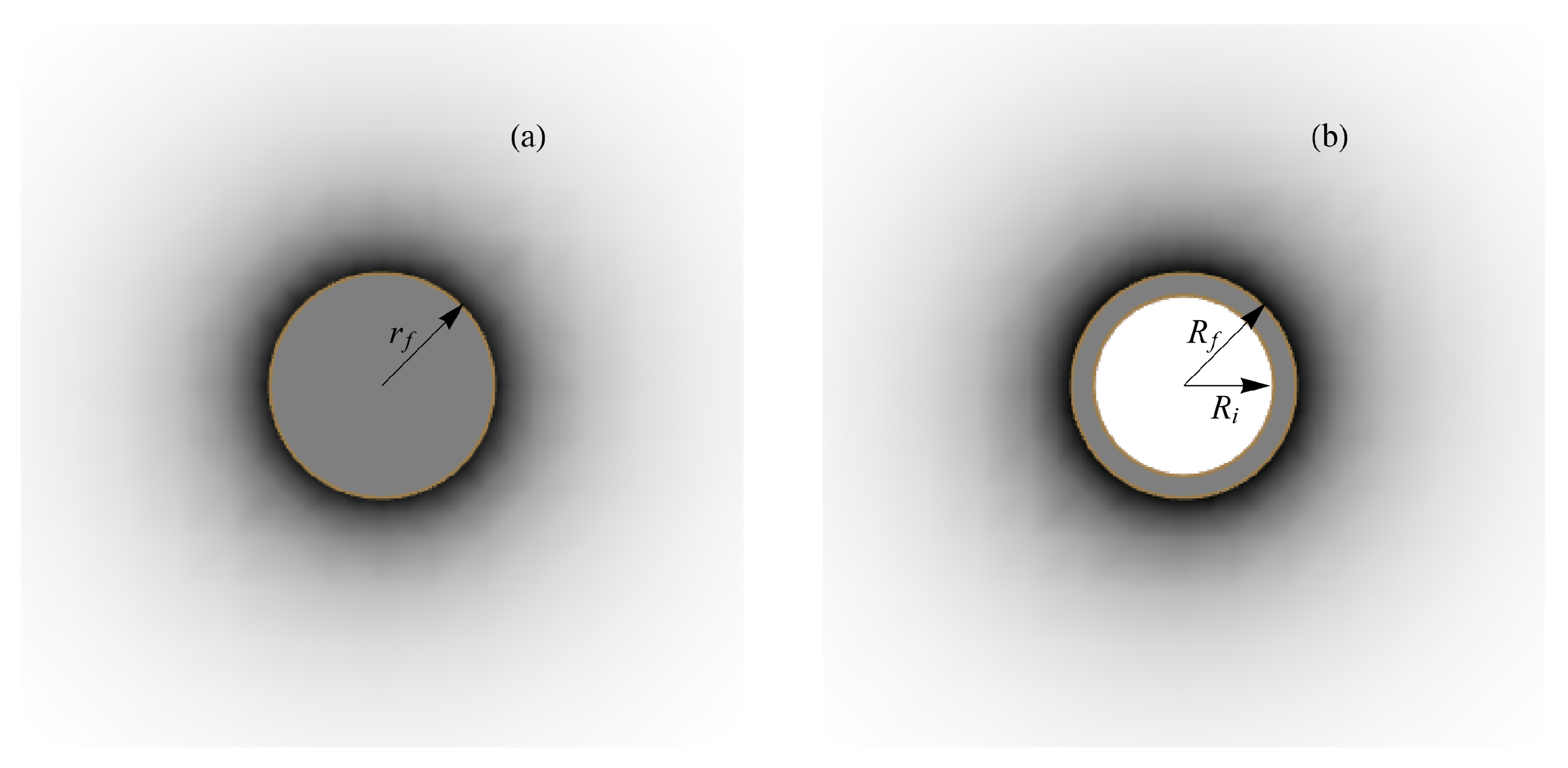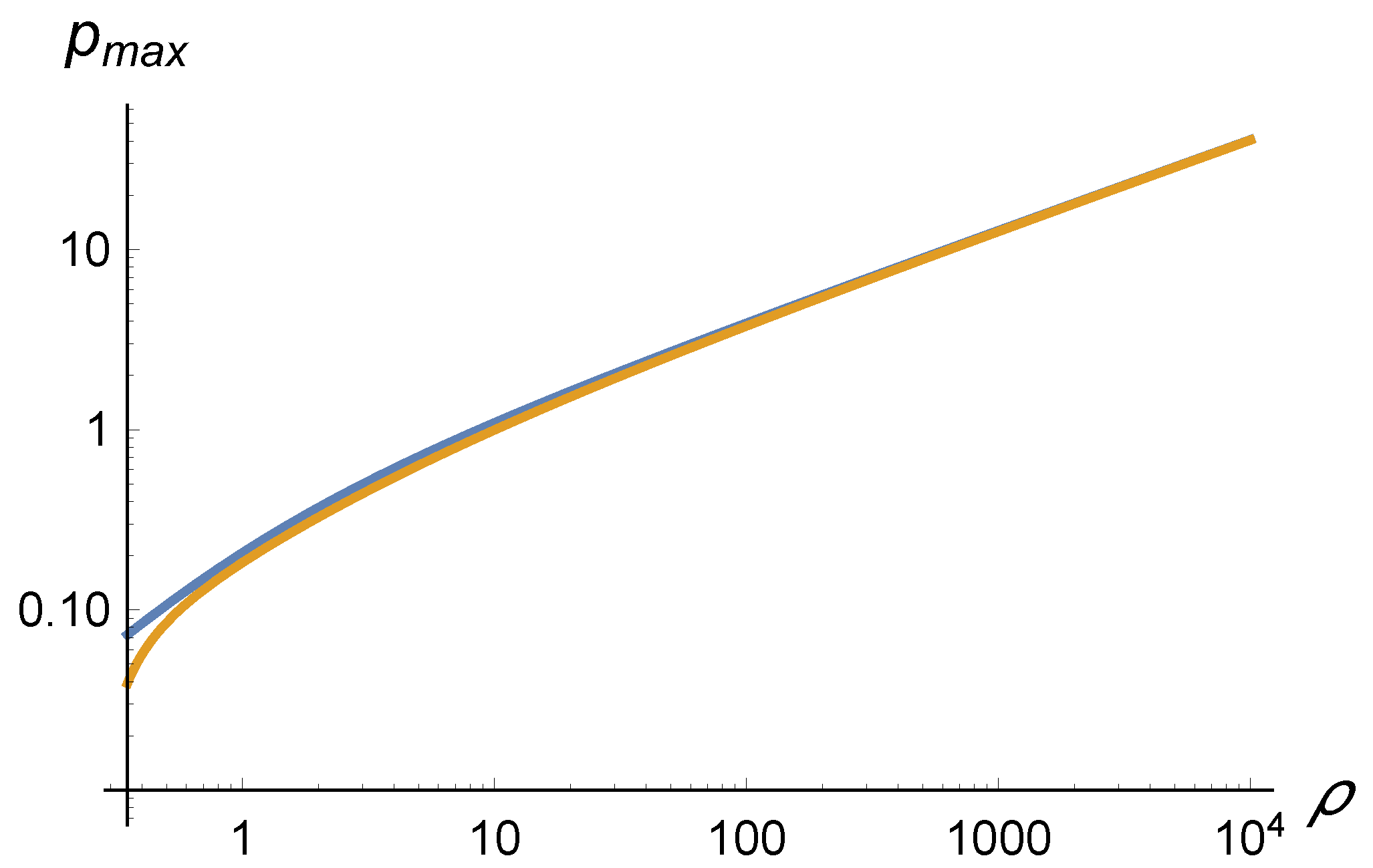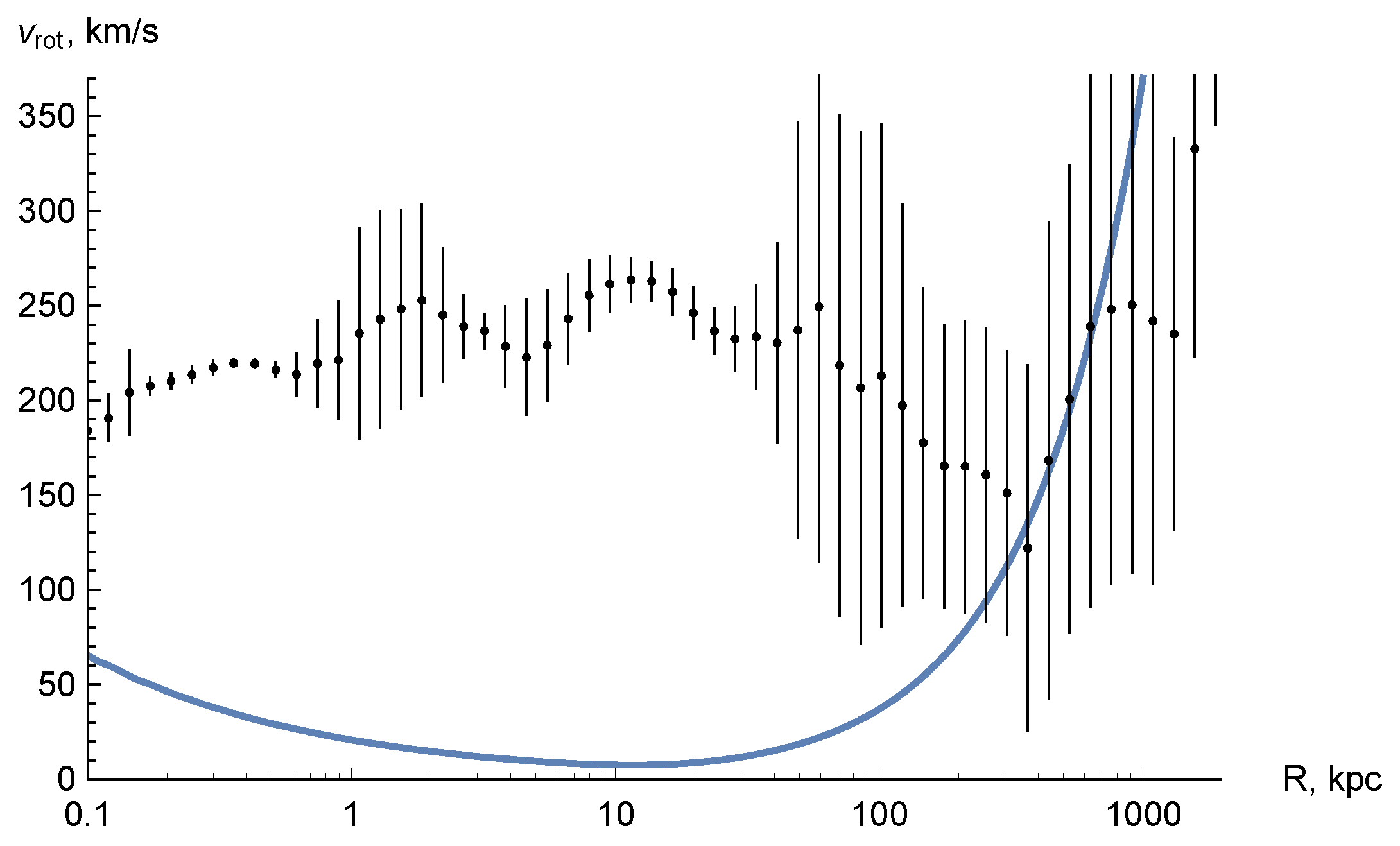Rotational Curves of the Milky Way Galaxy and Andromeda Galaxy in Light of Vacuum Polarization around Eicheon †
Abstract
1. Introduction
2. What Is “Eicheon”?
3. Vacuum Polarization around of Eicheon
4. Andromeda Galaxy
5. Discussion and Conclusions
Author Contributions
Funding
Data Availability Statement
Conflicts of Interest
Appendix A. TOV Equation for a Mixture of Ordinary and Dark Fluids
| 1 | |
| 2 | One could imagine, that “dark radiation” consists of virtual particles of some kind. We have considered [28] only scalar field, minimally coupled with gravity. |
References
- Gillessen, S.; Eisenhauer, F.; Trippe, S.; Alexander, T.; Genzel, R.; Martins, F.; Ott, T. Monitoring stellar orbits around the Massive Black Hole in the Galactic Center. Astrophys. J. 2009, 692, 1075–1109. [Google Scholar] [CrossRef]
- Nampalliwar, S.; Kumar, S.; Jusufi, K.; Wu, Q.; Jamil, M.; Salucci, P. Modeling the Sgr A* Black Hole Immersed in a Dark Matter Spike. Astrophys. J. 2021, 916, 116. [Google Scholar] [CrossRef]
- Abbott, R.; Abbott, T.; Acernese, F.; Ackley, K.; Adams, C.; Adhikari, N.; Adhikari, R.; Adya, V.; Affeldt, C.; Agarwal, D.; et al. GWTC-3: Compact Binary Coalescences Observed by LIGO and Virgo During the Second Part of the Third Observing Run. arXiv 2021, arXiv:2111.03606. [Google Scholar]
- Akiyama, K.; Alberdi, A.; Alef, W.; Asada, K.; Azulay, R.; Baczko, A.K.; Ball, D.; Baloković, M.; Barrett, J.; Bintley, D.; et al. First M87 event horizon telescope results. VI. The shadow and mass of the central black hole. Astrophys. J. Lett. 2019, 875, L6. [Google Scholar]
- Johnson, M.D.; Narayan, R.; Psaltis, D.; Blackburn, L.; Kovalev, Y.Y.; Gwinn, C.R.; Zhao, G.Y.; Bower, G.C.; Moran, J.M.; Kino, M.; et al. The Scattering and Intrinsic Structure of Sagittarius A* at Radio Wavelengths. Astrophys. J. 2018, 865, 104. [Google Scholar] [CrossRef]
- Landau, L.D.; Lifshitz, E. The Classical Theory of Fields; Butterworth-Heinemann: Oxford, UK, 1975; Volume 2. [Google Scholar]
- Chandrasekhar, S. The Mathematical Theory of Black Holes; Oxford University Press: New York, NY, USA, 1983. [Google Scholar]
- Cardoso, V.; Pani, P. Testing the nature of dark compact objects: A status report. Liv. Rev. Rel. 2019, 22, 1–104. [Google Scholar]
- Berti, E.; Barausse, E.; Cardoso, V.; Gualtieri, L.; Pani, P.; Sperhake, U.; Stein, L.C.; Wex, N.; Yagi, K.; Baker, T.; et al. Testing general relativity with present and future astrophysical observations. Class. Quant. Grav. 2015, 32, 243001. [Google Scholar] [CrossRef]
- Yagi, K.; Stein, L.C. Black hole based tests of general relativity. Class. Quant. Grav. 2016, 33, 054001. [Google Scholar] [CrossRef]
- Logunov, A.A.; Mestvirishvili, M.A. On the possibility of gravitational collapse in the relativistic theory of gravity. Theor. Math. Phys. 1997, 112, 1056–1067. [Google Scholar] [CrossRef]
- Barceló, C.; Liberati, S.; Sonego, S.; Visser, M. Fate of gravitational collapse in semiclassical gravity. Phys. Rev. D 2008, 77, 044032. [Google Scholar] [CrossRef]
- Chapline, G. Emergent Space-Time. In Beyond Peaceful Coexistence: The Emergence of Space, Time and Quantum; Licata, I., Ed.; Imperial College Press: London, UK, 2016; pp. 419–432. [Google Scholar]
- Carballo-Rubio, R.; Di Filippo, F.; Stefano Liberati, S.; Visser, M. A connection between regular black holes and horizonless ultracompact stars. J. High Energy Phys. 2023, 46, 1–24. [Google Scholar] [CrossRef]
- Carballo-Rubio, R.; Filippo, F.D.; Liberati, S.; Visser, M. Singularity-free gravitational collapse: From regular black holes to horizonless objects. arXiv 2023, arXiv:2302.00028. [Google Scholar]
- Schunck, F.E.; Mielke, E.W. General relativistic boson stars. Class. Quant. Grav. 2003, 20, R301. [Google Scholar] [CrossRef]
- Ray, S.; Sengupta, R.; Nimesh, H. Gravastar: An alternative to black hole. Int. J. Mod. Phys. D 2020, 29, 2030004. [Google Scholar] [CrossRef]
- Urbano, A.; Veermäe, H. On gravitational echoes from ultracompact exotic stars. J. Cosmol. Astropart. Phys. 2019, 2019, 011. [Google Scholar] [CrossRef]
- Singh, K.N.; Ali, A.; Rahaman, F.; Nasri, S. Compact stars with exotic matter. Phys. Dark Universe 2020, 29, 100575. [Google Scholar] [CrossRef]
- Hayward, S.A. Formation and evaporation of nonsingular black holes. Phys. Rev. Lett. 2006, 96, 031103. [Google Scholar] [CrossRef]
- Frolov, V.P. Notes on nonsingular models of black holes. Phys. Rev. D 2016, 94, 104056. [Google Scholar] [CrossRef]
- Sofue, Y. Rotation Curve and Mass Distribution in the Galactic Center—From Black Hole to Entire Galaxy. Publ. Astron. Soc. Jpn. 2013, 65, 118. [Google Scholar] [CrossRef]
- Baes, M.; Buyle, P.; Hau, G.K.; Dejonghe, H. Observational evidence for a connection between supermassive black holes and dark matter haloes. Mon. Not. R. Astron. Soc. 2003, 341, L44–L48. [Google Scholar] [CrossRef][Green Version]
- Dai, D.C.; Starkman, G.; Stojkovic, D. Milky Way and M31 rotation curves: ΛCDM versus MOND. Phys. Rev. D 2022, 105, 104067. [Google Scholar] [CrossRef]
- Chan, M.H.; Lee, C.M. Indirect evidence for dark matter density spikes around stellar-mass black holes. Astrophys. J. Lett. 2023, 943, L11. [Google Scholar] [CrossRef]
- Carr, B.; Kühnel, F. Primordial black holes as dark matter: Recent developments. Ann. Rev. Nucl. Part. Sci. 2020, 70, 355–394. [Google Scholar] [CrossRef]
- Bertone, G.; Tait, T.M. A new era in the search for dark matter. Nature 2018, 562, 51–56. [Google Scholar] [CrossRef]
- Cherkas, S.L.; Kalashnikov, V.L. Vacuum Polarization Instead of Dark Matter in a Galaxy. Universe 2022, 8, 456. [Google Scholar] [CrossRef]
- Birrell, N.D.; Davis, P.C.W. Quantum Fields in Curved Space; Cambridge University Press: Cambridge, UK, 1982. [Google Scholar]
- Brunetti, R.; Fredenhagen, K. Quantum Field Theory on Curved Backgrounds. In Quantum Field Theory on Curved Spacetimes: Concepts and Mathematical Foundations; Bär, C., Fredenhagen, K., Eds.; Springer: Berlin/Heidelberg, Germany, 2009; pp. 129–155. [Google Scholar] [CrossRef]
- Cherkas, S.L.; Kalashnikov, V.L. Æther as an Inevitable Consequence of Quantum Gravity. Universe 2022, 8, 626. [Google Scholar] [CrossRef]
- Cherkas, S.L.; Kalashnikov, V.L. Eicheons instead of Black holes. Phys. Scr. 2020, 95, 085009. [Google Scholar] [CrossRef]
- Cherkas, S.L.; Kalashnikov, V.L. Structure of the compact astrophysical objects in the conformally-unimodular metric. J. Belarusian State Univ. Phys. 2020, 3, 97–111. [Google Scholar] [CrossRef]
- Landau, L.D.; Lifshitz, E. Statistical Physics; Butterworth-Heinemann: Oxford, UK, 1980. [Google Scholar]
- Weidemann, V. White dwarfs. Ann. Rev. Astron. Astrophys. 1968, 6, 351–372. [Google Scholar] [CrossRef]
- Buchdahl, H.A. General Relativistic Fluid Spheres. Phys. Rev. 1959, 116, 1027–1034. [Google Scholar] [CrossRef]
- Weinberg, S. Gravitation and Cosmology: Principles and Applications of the General Theory of Relativity; John Wiley & Sons: New York, NY, USA, 1972. [Google Scholar]
- Kormendy, J.; Bender, R. The Double Nucleus and Central Black Hole of M31. Astrophys. J. 1999, 522, 772–792. [Google Scholar] [CrossRef]
- Bender, R.; Kormendy, J.; Bower, G.; Green, R.; Thomas, J.; Danks, A.C.; Gull, T.; Hutchings, J.B.; Joseph, C.L.; Kaiser, M.E.; et al. HST STIS Spectroscopy of the Triple Nucleus of M31: Two Nested Disks in Keplerian Rotation around a Supermassive Black Hole. Astrophys. J. 2005, 631, 280–300. [Google Scholar] [CrossRef]
- Sofue, Y. Dark halos of M 31 and the Milky Way. Publ. Astron. Soc. Jpn. 2015, 67, 75. [Google Scholar] [CrossRef]
- Navarro, J.F.; Frenk, C.S.; White, S.D.M. The Structure of Cold Dark Matter Halos. Astrophys. J. 1996, 462, 563. [Google Scholar] [CrossRef]
- Haridasu, B.S.; Cherkas, S.L.; Kalashnikov, V.L. A reference level of the Universe vacuum energy density and the astrophysical data. Fortschr. Phys. 2020, 68, 2000047. [Google Scholar] [CrossRef]



Disclaimer/Publisher’s Note: The statements, opinions and data contained in all publications are solely those of the individual author(s) and contributor(s) and not of MDPI and/or the editor(s). MDPI and/or the editor(s) disclaim responsibility for any injury to people or property resulting from any ideas, methods, instructions or products referred to in the content. |
© 2023 by the authors. Licensee MDPI, Basel, Switzerland. This article is an open access article distributed under the terms and conditions of the Creative Commons Attribution (CC BY) license (https://creativecommons.org/licenses/by/4.0/).
Share and Cite
Cherkas, S.L.; Kalashnikov, V.L. Rotational Curves of the Milky Way Galaxy and Andromeda Galaxy in Light of Vacuum Polarization around Eicheon. Universe 2023, 9, 424. https://doi.org/10.3390/universe9090424
Cherkas SL, Kalashnikov VL. Rotational Curves of the Milky Way Galaxy and Andromeda Galaxy in Light of Vacuum Polarization around Eicheon. Universe. 2023; 9(9):424. https://doi.org/10.3390/universe9090424
Chicago/Turabian StyleCherkas, Sergey L., and Vladimir L. Kalashnikov. 2023. "Rotational Curves of the Milky Way Galaxy and Andromeda Galaxy in Light of Vacuum Polarization around Eicheon" Universe 9, no. 9: 424. https://doi.org/10.3390/universe9090424
APA StyleCherkas, S. L., & Kalashnikov, V. L. (2023). Rotational Curves of the Milky Way Galaxy and Andromeda Galaxy in Light of Vacuum Polarization around Eicheon. Universe, 9(9), 424. https://doi.org/10.3390/universe9090424










